|

























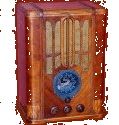
|
 |

My Collection of Vintage Computers

The Ferguson Big Board Computer
Z80 Processor Running CP/M
by Digital Research Computers
In the early 1980's the Ferguson Big-Board computer was offered by Digital Research Computers as a bare board, a kit,
or a ready-to-go populated board.
Just add power supplies, 8 inch disk drives, a keyboard, case, and monitor.
It was powered by a Z-80 processor with 64K of RAM and designed to run the CP/M operating system.
Since home computers had not arrived yet, or at least any that I could afford at the time, I decided to build a Ferguson "Big Board" so I
could do work at home.
More information and photos:
The Ferguson Big Board Computer
|
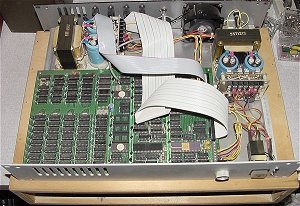 My Ferguson Big Board mounted in a case.
My Ferguson Big Board mounted in a case.
|

The First Portable Computer
The Osborne 1
by The Osborne Computer Corporation
In 1981 the Osborne Computer Corporation released what is
considered to be the first portable computer, the Osborne 1.
The Osborn's screen was very small, less than 5 inches wide, and could only display 52 characters per line. To view longer lines of text you had scroll side to side.
The keyboard doubled as the cover which became the bottom of the plastic case when it was packed up.
It had a handle on the back so it could be picked up and carried.
There were two 5¼ inch floppy disk drives, one located on each side of the monitor. Below each drive was a compartment for disk storage or as in the photo on the right, a place for the optional 300 baud modem.
|
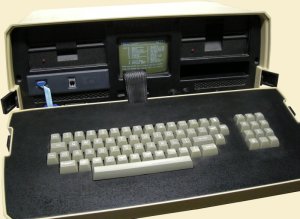 The Osborne 1 portable computer.
The Osborne 1 portable computer.
Larger Photo
Screen
Case
|

The Timex Sinclair 1000 and Sinclair ZX-81
by Sinclair Research Ltd.
Of the many home computers released in 1982, the Timex Sinclair was the least expensive at $99 and most
likely the smallest. It was a clone of Sinclair's previous ZX-81. Its small circuit board only contained four ICs and a few components.
The ZX-80 and 1000 were only 6½ inches wide by 6¾ inches deep.
The 1000 had a built in membrane keyboard, 2K of memory, ran a version of Basic, and weighed less than one pound.
It hooked to a standard analog TV. Other options included a 16K memory expander, cassette drive, and printer.
Many found the membrane keyboard hard to use, so much in fact that several companies offered mechanical keyboards to
replace the original in the ZX81 and 1000. Although it was difficult to load programs with the cassette, the low initial
cost was probably the main factor that led to over a half million units being sold in a short time.
Larger Photo
Books, Games, Accessories
1000 Bottom
Board
ZX-81 and 1000
|
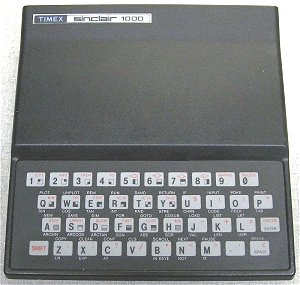 The Timex Sinclair 1000.
The Timex Sinclair 1000.
|

Kaypro II
by Non-Linear Systems
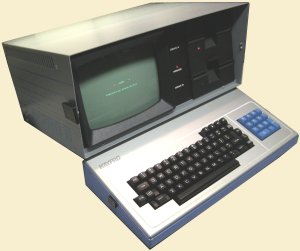 The Kaypro II Portable Computer.
The Kaypro II Portable Computer.
|
In 1982 Non-Linear Systems (NLS) produced the popular Kaypro II portable computer.
Up till then Non-Linear Systems was best known for manufacturing the first digital meter.
The II had a Z-80 microprocessor and ran the CP/M operating system. It had a large 9 inch screen with two 5¼ floppy drives. It was housed in a metal case with a carrying handle and
like the Osborne I portable, the keyboard doubled as the cover. The Kaypro II cost $1,795 and came bundled with a large selection of software including CP/M, word processing and a spread sheet programs.
In 1983 The Kaypro computer division was split away from NLS and Kaypro Corporation was formed.
Note that the Kaypro II was the first Kaypro model and the Kaypro 1 was the last model produced by Kaypro almost ten years later.
Kaypro's insistence on staying with the CP/M operating system and re-releasing reconfigured old models were major factors in their demise.
|

The Commodore 64
by Commodore Business Machines Inc.
The Commodore 64 is by far the most popular computer of all time. During the C64's lifespan Commodore sold
over 17 million units along with a wide range of peripherals, games, and software. It was a remarketed version of Commodore's VIC-20.
Running a MOS 6510, 1MHz CPU, the C64 was capable of high-resolution color graphics and sound making it excellent for gaming.
Storage was accomplished using an external Commodore "Datasette" recorder, and later an external floppy disk drive.
|
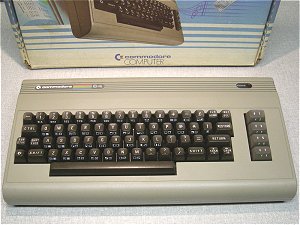 The Commodore 64.
The Commodore 64.
Larger Photo
C64 Connection Diagram
|

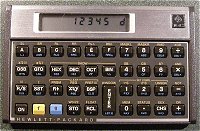 |
HP 16C "Computer Scientist"
The HP 16C Computer Scientist was designed for computer programmers. It performs calculations and conversions in decimal, hexadecimal,
octal, and binary. This calculator has enough memory for storing over 200 lines of programing.
Larger Photo
Introduction from manual
|

Texas Instruments Silicone Wafer - 1990 16 Mb Award
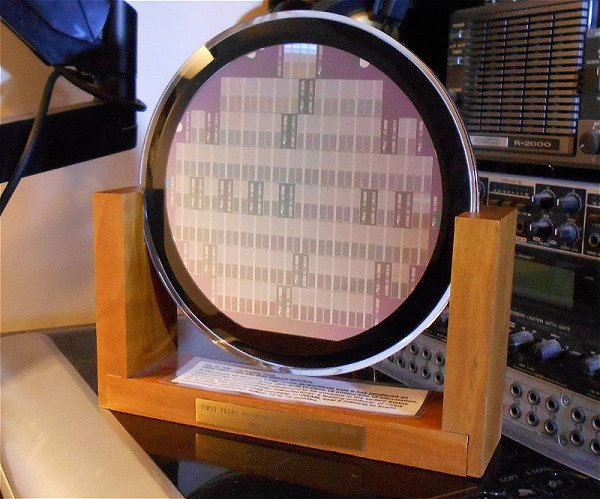 |
Silicone Wafer Award? - Display? - Plaque reads:
"First Texas Instruments 16 Megabit Fab FBFC
DMOS IV 2/12/90"
All I could find were several Feb. 1990 newspaper announcements about TI producing an experimental Super-Memory 16 Megabit chip.
Wafer is encased in what looks to be some type of heavy Lexan. No clue, anyone remember?

|

Toshiba Hard Drive
 |
Most likely the smallest mechanical hard drive manufactured. It's about the size of a quarter and holds 4 GB.
Larger Photo
|

|
|













